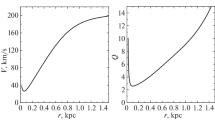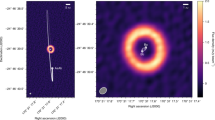Abstract
Algebraic expressions are obtained for the interaction potential energy of a pair of galaxies in which one is disk shaped and the other spherical. The density distribution in the disk galaxy is represented by a polynomial in ascending powers of the distance from the centre of the disk while the density distribution in the spherical galaxy is represented by the superposition of spherical polytropes of integral indices. The basic functions required for obtaining the interaction potential energy of a coplanar disk-sphere pair of galaxies are tabulated. The forces of attraction between a coplanar disk-sphere pair of galaxies are shown graphically for two density models of disk and spherical galaxies. An overlapping coplanar disk-sphere pair of galaxies attract just like two mass-points at a certain separation,r c, of their centres. The force of attraction is less than that of two mass-points having masses equal to the masses of the two galaxies, if the separation of the centres is less thanr c, and greater if the separation is greater thanr c.
For a typical coplanar disk-sphere pair of galaxies (the density of the disk is represented by Model II and of the sphere by a polytropic indexn=4) of equal radii, we note the following. At a separation of 0.79R, R being the common radius of the two galaxies, the force of attraction between the pair is the same as if the entire mass of each galaxy is concentrated at its centre. The mass-point model for the two galaxies will overestimate the force of attraction by more than a factor of 10 if the separation is less than 0.36R. For separation greater than the radii of the galaxies the mass-point model will underestimate the force but the departure in this case is less than 33%.
Similar content being viewed by others
References
Arp, H.: 1966, ‘Atlas of Peculiar Galaxies’,Astrophys. J. Suppl. 14, No. 123.
Ballabh, G. M.: 1973,Astrophys. Space Sci. 24, 535.
Gradshteyn, I. S. and Ryzhik, I. W.: 1965,Tables of Integrals, Series and Products, Academic Press, New York.
Limber, D. N.: 1961,Astrophys. J. 134, 537.
Potdar, A. and Ballabh, G. M.: 1974,Astrophys. Space Sci. 26, 353.
Author information
Authors and Affiliations
Rights and permissions
About this article
Cite this article
Ballabh, G.M. Gravitational potential energy of a disk-sphere pair of galaxies. Astrophys Space Sci 38, 407–418 (1975). https://doi.org/10.1007/BF00647142
Received:
Issue Date:
DOI: https://doi.org/10.1007/BF00647142




